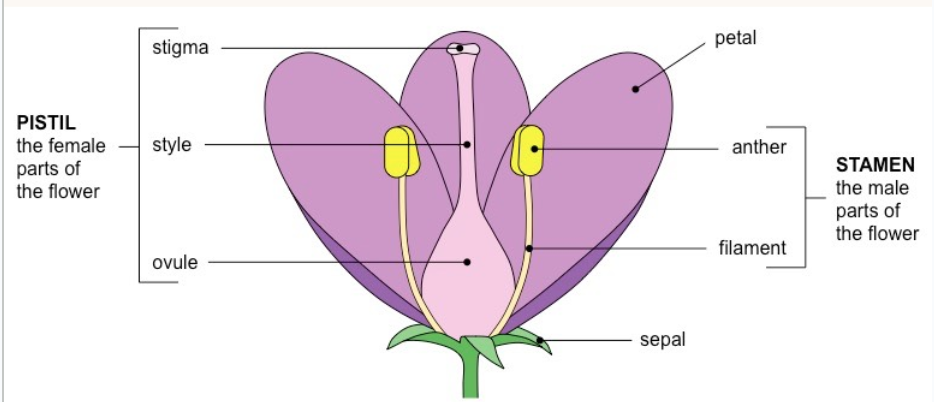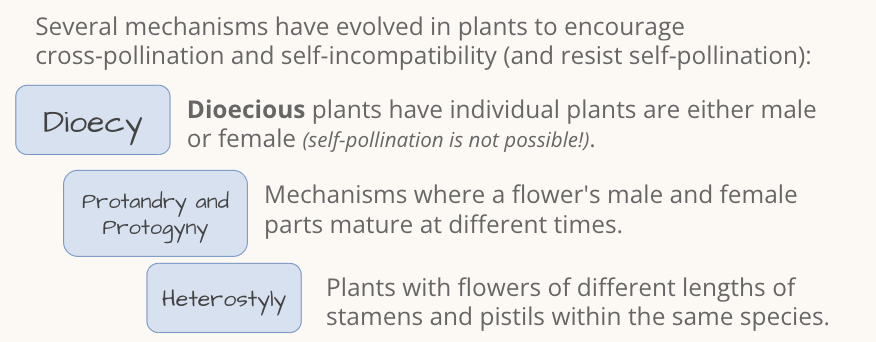D3.1 (Reproduction in Plants and Animals)
1/18
There's no tags or description
Looks like no tags are added yet.
Name | Mastery | Learn | Test | Matching | Spaced |
|---|
No study sessions yet.
19 Terms
Compare sexual and asexual life cycles
Life reproduces in one of two ways:
Asexually:
The formation of offspring from a single parent cell(s) that are genetically identical to the parent.
Sexually:
Requires two different sex cells (haploid cells) from two different individuals fusing together to reproduce the first cell (diploid cell) of a new organism.
Discuss the advantages and disadvantages of asexual reproduction
Asexually:
(Advantages)
It's fast (faster than sexual reproduction, which always starts with a single cell).
It's easy - no partner needed!
(it costs time and energy to ensure sperm meets egg).
All beneficial traits will be cloned.
(Disadvantages)
No variation = diseases are easily transmitted
Fast reproduction = resources get used up too fast
No variation = offspring can't adapt to big changes in the environment
Outline the main mechanisms of asexual reproduction
Binary Fission
A rapid method of asexual reproduction employed by prokaryotic cells.
The circular DNA is first copied in response to a replication signal and then cytokinesis separates the membranes, forming two cells with identical DNA molecules.
Budding
The growth of cells on a parent organism, which eventually separate from the parent to
form an autonomous organism. This method of cloning occurs in species of Hydra, but is also common to
many species of yeast (fungi).
Fragmentation
The growth of a new organism from a separated portion of a parental organism.
From the fragment, the offspring will develop to be morphologically identical to the parent.
Fragmentation is common to starfish, as well as certain species of annelid worms.
Vegetable Propagation
When sections of a plant break off and grow independently. This is because all plants possess meristematic tissue which is totipotent (undifferentiated).
Virtually all types of roots and shoots are capable of vegetative propagation.
Spore Formation
Some plant species form spores via an alternating cycle of generations.
A diploid plant will form a haploid spore (via meiosis) that will then germinate to form a haploid plant.
The haploid plant then produces gametes (via mitosis) which can fuse with another haploid gamete to form a diploid offspring.
Parthenogenesis
An offspring develops from an unfertilised gamete. While there are different mechanisms by which this can occur, it usually involves the production of a diploid egg cell by the female parent.
This process occurs in certain species of insects, fish and reptiles.
Draw and label an animal pollinated flower*

State the functions of the main parts of a flower (9)
Anther – pollen producing organ of the flower (pollen is plant sperm).
Filament – slender stalk supporting the anther (makes the anther accessible to pollinators)
Stamen - the male reproductive part of a flower
Stigma – the sticky, receptive tip of the pistil that is responsible for catching the pollen.
Style – the tube-shaped connection between the stigma and ovule (it elevates the stigma to help catch pollen).
Ovule – the structure that contains the female reproductive cells (after fertilisation, it will develop into a seed).
The female part of the flower is called the pistil (or carpel)
Petals – brightly coloured modified leaves, which function to attract pollinators.
Sepal – Outer covering which protects the flower when in bud,
Peduncle – Stalk of the flower.

I is the stigma which receives the pollen/where pollen lands/is captured (during pollination);
II is the anther and produces/contains/releases pollen;
Both name and function must be included in each marking point.
The role in pollination should be stated. Do not accept “pollination” on its own.
female gamete/ovule is produced/meiosis to produce ovules/ovule develops;
Fertilisation occurs
OR
fusion/union of male and female gametes/nuclei;development of seed (from fertilised ovule);
development of fruit (from the whole ovary);
Mpb: Do not accept union of pollen and ovule (Too vague).
Do not accept carpel/pistil as equivalent of ovary
attracts an insect/animal/which pollinates the flower;
attracts a pollinator;
Mpa: Both parts of the sentence are needed to award the point.
Define pollination, fertilization and seed dispersal
Sexual reproduction in flowering plants involves the transfer of pollen (male gamete) to an ova (female gamete).
Define pollination, fertilization and seed dispersal
The transfer of pollen grains from an anther (male plant structure) to a stigma (female plant structure)
Fusion of a male gamete nuclei with a female gamete nuclei to form a zygote.
Moving a seed away from the paternal plant (to prevent both parent + offspring competing for the same resources)
State the changes to the ovule and ovary that result from fertilization
Once fertilized, the ovule develops into a seed and the ovary develops into a fruit.
Define cross-pollination
Cross-pollination is the process by which pollen from the anther (the male part) of one flower is transferred to the stigma (the female part) of another flower of the same species (or a closely related species).
Cross-pollination can occur through various agents such as wind, water, insects (e.g. bees and butterflies), birds, and other animals (see D3.1.12).
Outline the benefits of cross-pollination and self-incompatibility in flowering plants
Cross pollination is an essential mechanism for genetic diversity in plants, as it allows for the mixing of genetic traits from different plants, potentially leading to offspring with new combinations of traits that may be more adaptable to their environment.
List methods for promoting cross-pollination in flowering plants

In dioecious plants, the entire plant is either male, or female. Cross-pollination is necessary for reproduction because a plant cannot self-pollinate.
In protandry (see right), the male parts mature first. In protogyny (see left), the female parts mature first.
This off-timing reduces the chances of self-pollination.
Heterostyly: Flowers on the same species have different styles (lengths of the pistil) and stamens*.
Define self-incompatibility
Self-incompatibility in plants is a genetic mechanism that prevents self-fertilization and promotes cross-pollination
Self-fertilization can lead to an “inbreeding depression” – a decline in vitality, fertility, and resistance to stress - all a result of a lack of genetic diversity.
Outline the mechanism that promotes self-incompatibility in flowering plants
Self-incompatibility (SI) is a complex genetic system in plants in which a plant can recognize and reject its own pollen or the pollen from genetically similar individuals.
Common self-incompatible plants include tomatoes, potatoes, and Brassica (broccoli, mustard, etc)
Self-incompatible plants avoid self-pollination via different forms of proteins produced from a gene called the S-allele.

List mechanisms of seed dispersal
Angiosperms have evolved a variety of ways to disperse their seeds.
The structure of the seed will vary depending on the mechanism of dispersal employed by the plant.
Animal dispersal (via both eating and sticking)
Water dispersal (eg. coconut)
Burst dispersal (eg. peas, exploding cucumber)
Fire dispersal
Define germination
Germination is the process by which a seed begins to sprout.
When fertilisation occurs in angiosperms, the ovule will develop into a seed (which may be contained within a fruit).
Outline why water, oxygen and warmth are required for germination
Oxygen - for aerobic respiration (the seed requires large amounts of ATP in order to develop).
Temperature - For optimal function of enzymes, seeds require certain temperature conditions in order to sprout.
pH - Also for optimal function of enzymes, seeds require a suitable soil pH in order to sprout.
Water - to metabolically activate the seed (triggers the synthesis of gibberellin)
Outline the role of gibberellin during germination
Gibberellin (GA) is a plant hormone that regulates a wide range of processes involved in plant growth and development.
Gibberellin stimulates mitosis and cell division in the embryo.
It is also needed to trigger the synthesis of amylase, to break down starch in the food reserves, which can then be used for respiration.
Write five example problem questions for experiments that could test factors affecting germination
Fire - some seeds will only sprout after exposure to intense heat (e.g. eucalyptus, lodgepole pine, etc).
Freezing - some seeds will only sprout after periods of intense cold (e.g. in spring, following the winter snows). Ex: cyclamen
Digestion - some seeds require prior animal digestion to erode the seed coat before the seed will sprout.
Scarification - Seeds are more likely to germinate if the seed coat is weakened from physical damage.
This obviously takes place primarily from natural causes - e.g. damage from dispersion, digestion, etc.
Scarification can be mechanical, chemical, thermal (heat OR, frost damage), and acidic (from ph).